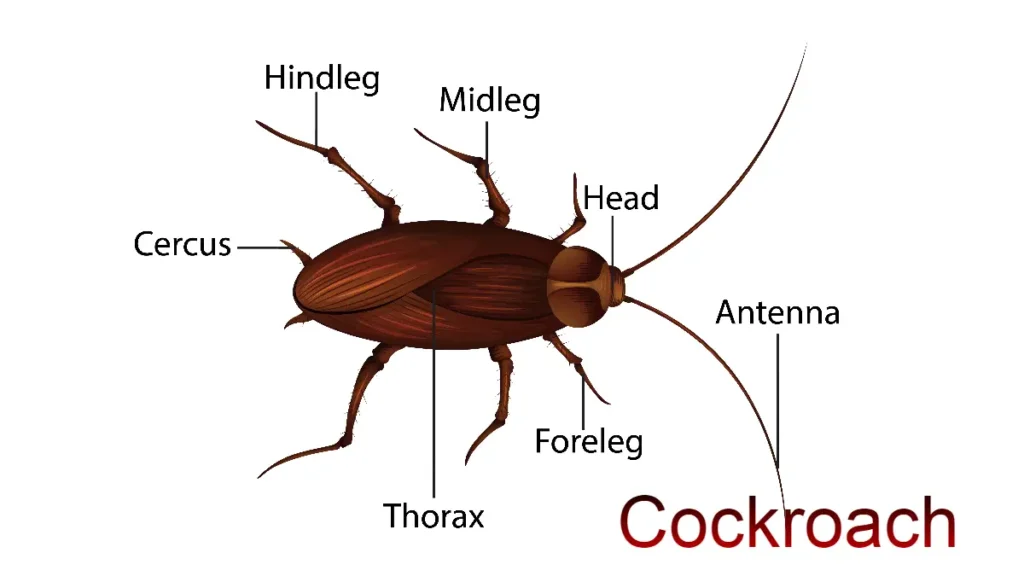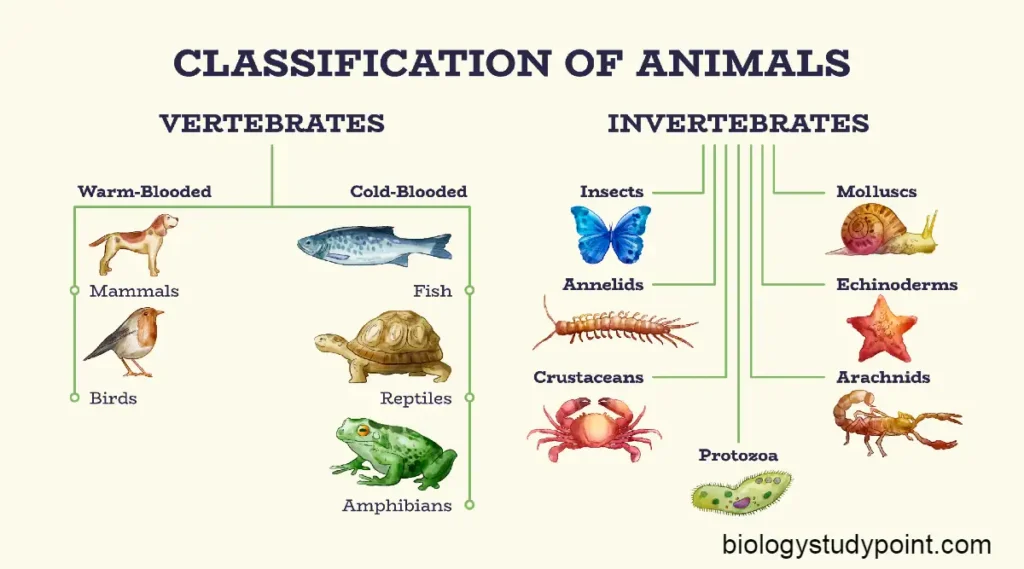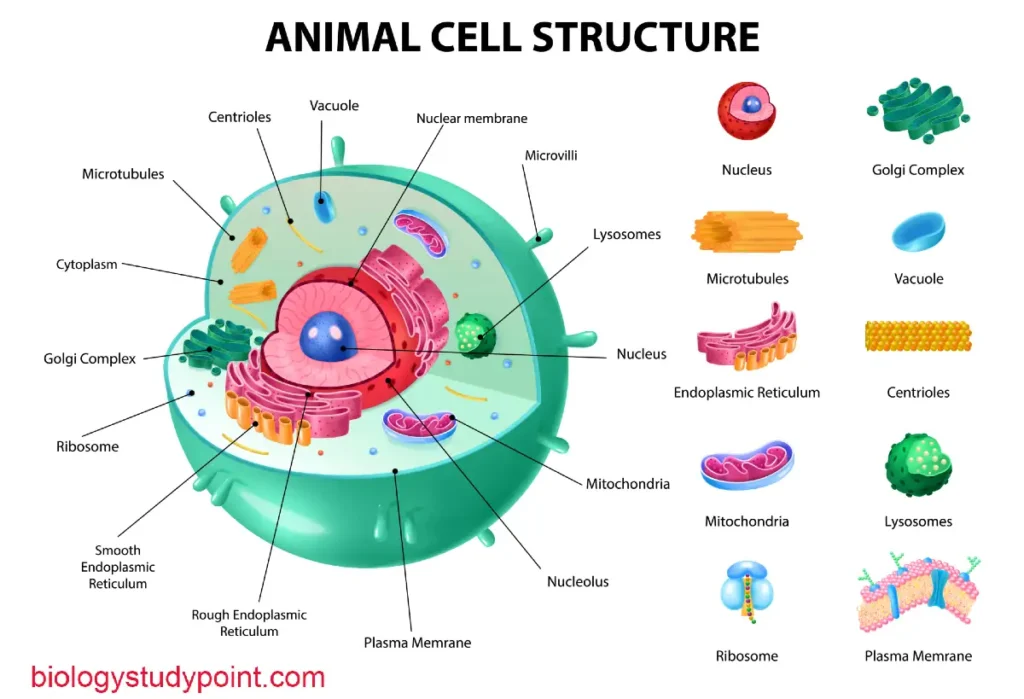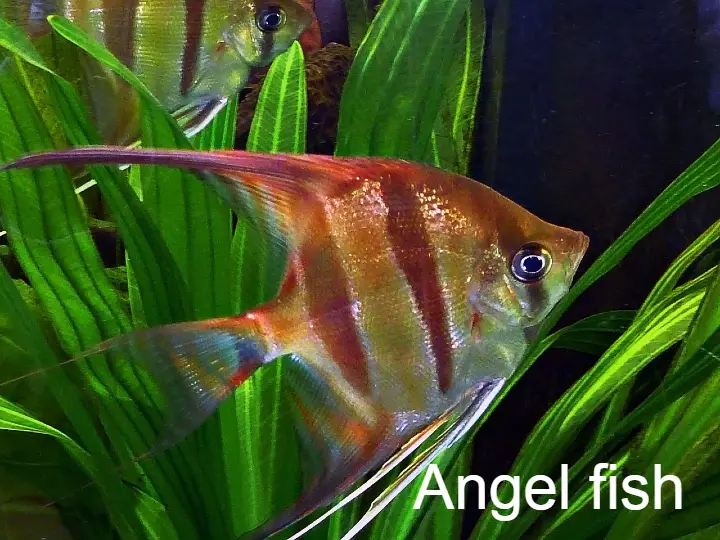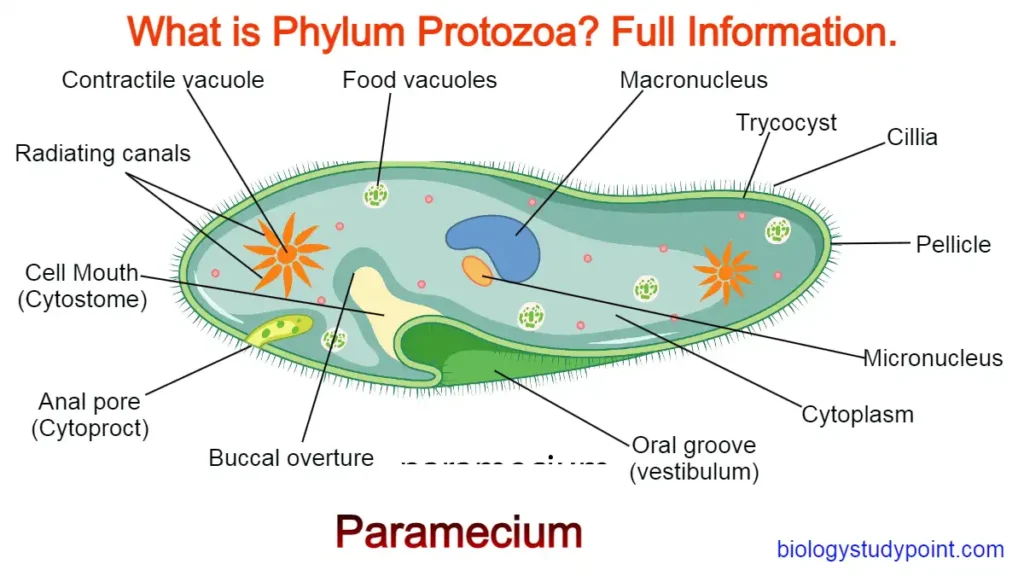Hello friends, in this article, you will get complete information about the cockroach, including the lifespan of a cockroach, external morphology, internal morphology, classification, digestive system, and respiratory system of cockroaches. So, let’s start.
What is the lifespan of a cockroach?
Talking about the lifespan of cockroaches ranges between 7–12 months, but sometimes cockroaches can survive for 1.5-2 years. Their lifespan depends on the species, environmental conditions, and available resources. This rule applies to almost all living beings.
In this article, we will delve into the details of cockroaches. I guarantee you will learn a lot about cockroaches if you read this article thoroughly. Let’s explore everything about cockroaches from A to Z.
What is a cockroach?
The cockroach is an insect found all over the world. It is omnivorous and nocturnal, thriving in kitchens, hotels, bakeries, restaurants, warehouses, sewage systems, and public areas. Moreover, they carry various harmful bacteria and germs such as cholera, diarrhea, tuberculosis, and typhoid, earning them the title of “Vectors.”
This was some basic information about cockroaches. Now, let’s move on to their classification.
Classification of Cockroaches:
| Phylum | Arthropoda |
| Class | Insecta |
| Order | Orthoptera |
| Genus | Periplaneta |
| Species | americana |
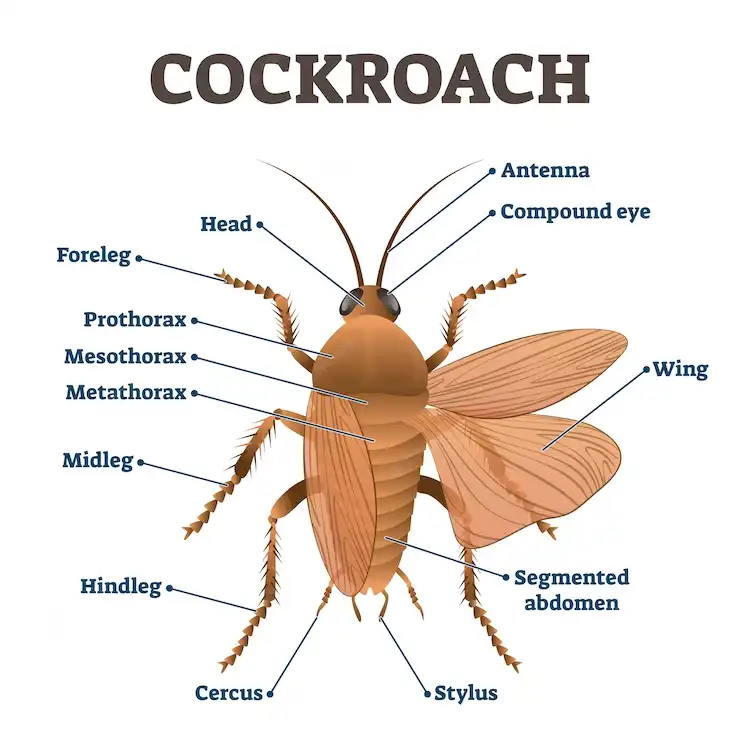
Now, let’s discover the scientific name of the cockroach.
What is the scientific name of a cockroach?
The scientific name of the cockroach is Periplaneta americana. The scientific name of any organism comprises its genus and species taken together.
Firstly, let’s discuss the classification of cockroaches.
The cockroach belongs to the Phylum Arthropoda. This phylum is characterized by jointed appendages and an outer skeleton made of chitin.
Now, moving on to their class, cockroaches are placed in Class – Insecta, meaning they are insects. The main characteristic of this class is the presence of three pairs of legs, totaling six legs; hence, they are called Hexapoda.
Next, we will examine the external morphology of cockroaches.
Morphology of Cockroach:
- Cockroaches are brown.
- Their exoskeleton is made of chitin, as is the case with all arthropods.
- The body of the cockroaches is segmented, with each segment having an exoskeleton made of chitin called sclerites.
- The dorsal or upper part of the cockroach is called Tergites, while the ventral or lower part is called Sternites. These parts are connected by a membrane known as the arthrodial membrane, and the lateral parts’ sclerites are also called Pleurites.
How many parts is the body of a cockroach divided into?
The cockroach’s body is divided into three parts:
- Head
- Thorax
- Abdomen
Head:
During the embryonic stage, their head has six segments, which form the adult head. Their head is triangular and perpendicular to the central axis, forming a 90-degree angle known as Hypognathus.
Their head features appendages, including antennae for tactile and olfactory sensory functions, aiding food detection. Additionally, they have compound eyes and mouthparts for biting and chewing, known as the Mandibular type. These mouthparts include upper jaws (Maxillae), lower jaws (mandible), labrum (upper lip), labium (lower lip), and a hypopharynx acting as a tongue.
Thorax:
Their thorax has three segments in the embryonic stage, which remain in adulthood:
- Pro-thorax
- Meso-thorax
- Meta-thorax
Each segment has a pair of legs, resulting in three pairs of legs. The widest part of their leg is the Coxa and the longest is the Tibia.
Cockroaches have two pairs of wings. The first pair originates from the mesothorax, known as forewings, which are light to dark brown and leathery, serving as a cover during rest. The second pair of wings is derived from the metathorax, known as the hind wings, which are membranous and transparent, enabling flight.
Abdomen:
Their abdomen has 11 segments during the embryonic stage, reducing to 10 in adulthood. Female cockroaches exhibit 7 visible segments, while males show nine segments. Female cockroaches have a boat-shaped 7th sternite, forming the genital pouch, with the 8th and 9th sternites containing female pores (gonophore), spermatheca pores, and collateral glands.
Cockroaches are unisexual, with males and females differentiated based on morphology, a feature called sexual dimorphism. Male cockroaches are flattened with anal styles on the 9th sternite, whereas females lack anal styles and are slightly swollen. Additionally, both males and females have anal cerci on the 10th tergite segment, sensitive to vibration.
Also, read –
What is the animal kingdom? Complete notes.
What is the plant kingdom? Full Information.
What is biology’s definition and branches?
What is a cell wall? Complete notes
“Now we will read about the mechanism of cockroaches.”
Anatomy of Cockroach
The digestive system of cockroaches:
Their digestive system is divided into three parts:
- Fore-gut
- Mid-gut
- Hind-gut
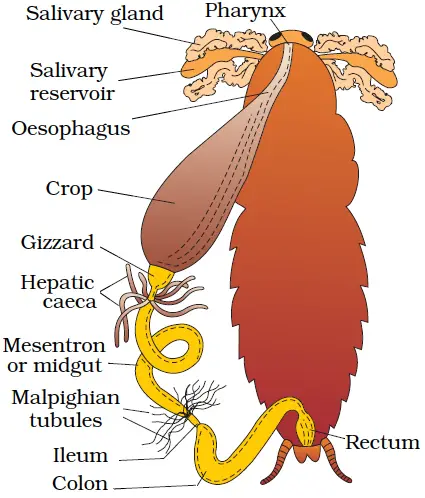
Fore-gut
It is layered with a cuticle. The mouth, pharynx, Lagrangian, esophagus, crop, and gizzard come under this. The crop in it stores food, and the gizzard has chitinous teeth that work to grind the food.
Mid-gut
Between the foregut and midgut, 6-8 cecums secrete digestive enzymes. These are called hepatic caecae.
Hindgut
It is also layered with a cuticle and is wider than the midgut. It differentiates into the ileum, colon, and rectum, which open out of the anus. Between the mid-gut and hindgut, 100 – 150 Malphigian tubules perform the function of excretion.
Blood vascular system of cockroaches
The circulatory system in cockroaches is an open type. The open type means that these do not have blood vessels or are poorly developed. This means it flows in open areas. Their heart is neurogenic. Neurogenic means that the heart cannot be excited by itself; the impulse or information in the heart to excite comes from the nervous system. That’s why it is called Neurogenic. Their heart is connected to the alary muscles and has 13 contractile segments, while the heart of all vertebrates is myogenic, meaning it is self-exciting.
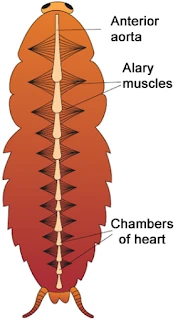
Cockroaches’ blood is called hemolymph because their blood is colorless. It is colorless because there is no respiratory pigment in their blood. Hemoglobin, Hemocyanin, etc., are absent, and their cells are called Hematocytes.
Due to the absence of respiratory pigment in their blood, it does not work in transporting gases but only serves to provide nutrition.
The Respiratory System Of Cockroaches
Cockroaches have respiratory organs called tracheal tubes for respiration. These tracheae are divided into small branches called tracheoles, which direct oxygen to the tissues.
And these tracheal tubes open outwards. These holes are called spiracles. The number of these holes is 10 pairs: 2 pairs are in the thoracic part, eight are in the abdominal part, and all these holes are in the lateral part. And these spiracles are regulated by the Sphincter muscle.
SPIRACLES → TRACHEA → TRACHEOLES → TISSUES
Excretory system of cockroach
These insect classes extract waste material, uric acid, in their excretion; hence, they are called Uricotelic. The main excretory structure of a cockroach is the Malphigian tubule. These tubules contain glandular epithelium and, along with it, ciliated cells.
These Malphigian tubules convert nitrogenous wastes into uric acid and pass it out through the hindgut or anus.
Not only this but there are other excretory structures in it. These are as follows:
- Fat body
- Nephrocytes
- Urecose glands
The nervous system of cockroaches
The cockroach has two solid nerve cords in the ventral part. This happens mainly in the chest and abdomen. There are three pairs of ganglia in the thoracic region and about six pairs of ganglia in the abdomen. That’s why they survive for 7–10 days, even after their head is cut off.
Two types of nerve rings are found in their heads:
- Supra-oesophageal ganglia: It goes to Antennae, Eye, and Labrum.
- Subesophageal ganglia: It goes to the maxillae, mandible, and labium.
The reproductive system of cockroaches:
So, friends, first, we will read about the male reproductive system.
Male reproductive system
They have a pair of testes in their body’s 4th, 5th, and 6th segments. The vas deferens emerge from these testes and open into the uterine gland. This gland is present in the 6-7th abdominal segment. Inside this gland, there are spermatic cords and long and short tubules. Another gland attached to the top of the utricle gland is called the Phallic or conglobate gland.
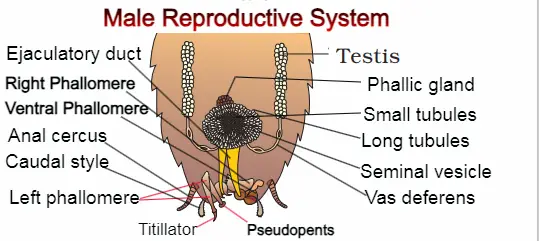
Downward from the utricle gland, an ejaculatory duct emerges, which opens into the phallomere.
In male cockroaches, the accessory reproductive glands are phallic and utricle glands, which convert sperm into packets, meaning that all sperm stick to each other and are arranged in packets. These are called Spermatophores.
Describe the female reproductive system of cockroaches.
Female reproductive system
The female has a pair of ovaries in the 2nd-6th segment, and each ovary has eight ovarian tubes, and ovipositors emerge from the ovaries. Their sixth segment contains the spermatheca, which temporarily stores sperm.
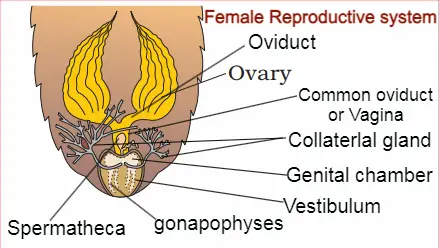
Above it is present the vagina, and below it is present the gonad chamber and vestibulum below the gonad chamber. The germinal chamber and the vestibulum together are called the genital chamber. This happens in the 7th, 8th, and 9th segments. In this, the accessory reproductive glands are collateral.
In this, the process of fertilization takes place in the Genital chamber, i.e., internal fertilization takes place. After fertilization, the fertilized eggs are covered with a capsule called Ootheca. Collateral glands form the covering of the capsule.
The female cockroach lays 9-10 ootheca at a time, and each Ootheca contains 14 to 16 fertilized eggs.
Development in Cockroach:
Their development is Paurometabolous (incomplete) type. Incomplete means their larva, which is called Nymph, is like an adult. It has all the characteristics of an adult; it does not have wings, while the adult has wings. They become adults after 13 moultings.
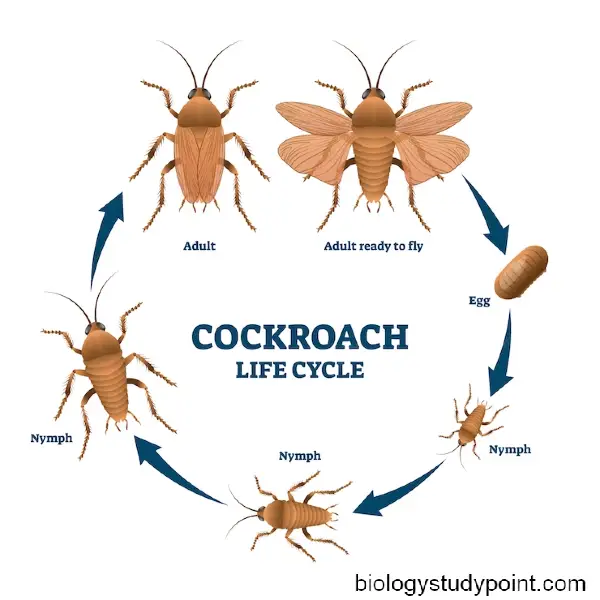
Many species of cockroaches are wild. About 30 of the 4,600 species are associated with human habitation. Diploptera punctata, the cockroach, produces a nutritionally dense crystalline “milk” to feed its young. It is found in Myanmar, China, Fiji, Hawaii, and India. Scientists believe that cockroach milk could be the superfood of the future.
Frequently Asked Questions
How many chambers are there in the heart of a cockroach?
There are a total of 13 chambers or chambers in the heart of a cockroach.
How long can a cockroach hold its breath?
Cockroaches can hold their breath for 45 minutes.
Read the complete article to answer all the questions given below.
- How many legs does a cockroach have?
- What is the name of the respiratory organ in cockroaches?
- How does air enter the cockroach’s body?
“Friends, I hope you have liked the information given about cockroaches. What is the lifespan of a cockroach? If you have liked this information, then please share it as much as possible.”
Thank you
